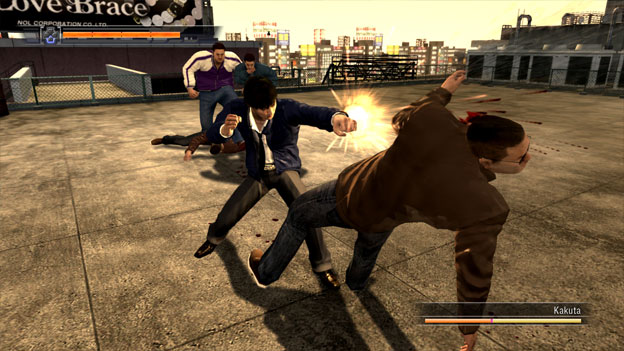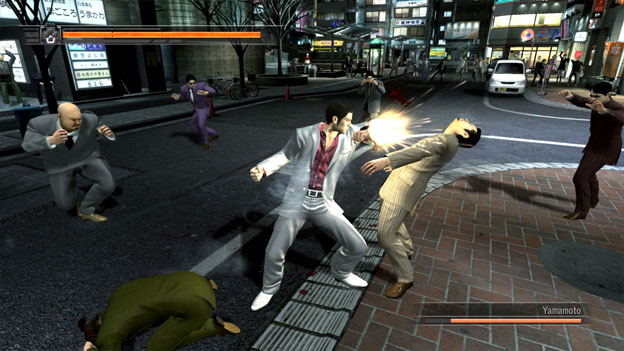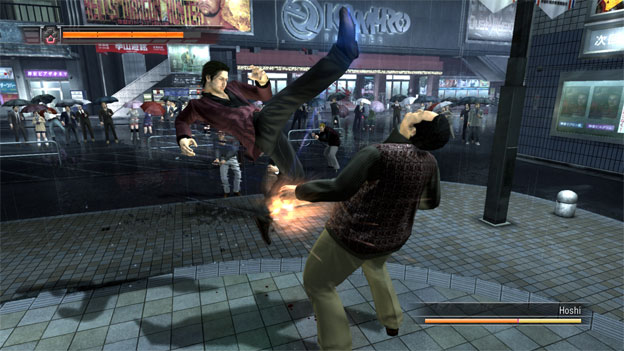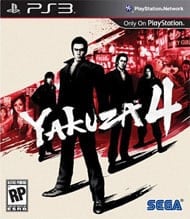Japan’s Swan Song
Playing through Yakuza 4 was actually kind-of sad. Not because it’s a bad game – far from it – but rather because to me it represents everything that has been lost in the decline of the Japanese gaming industry. This is a game that is so completely opposite to the ideals of Western game design that it could only have come from Japan. The fact that this may be one of the very last of its ilk is a source for great sadness from anybody who treasured Japan’s great contribution to gaming culture.
Modern Western games focus on gameplay above all else, as if anything less would constitute a breach of contract with their consumers. They strive to make every five-minute period have at least six explosions out of a self-conscious (though largely justified) fear that they will lose their customer’s attention if even a moment of boredom crops up.

Yakuza 4 doesn’t see the world this way. The entire game is chopped up into “chapters” of about forty-five minutes long. Most chapters include about ten minutes of gameplay. Nearly everything else is a gigantic cutscene. The game doesn’t shy away from yanking the controller out of your hand to start up a new cutscene. There are times where one scene will end, give you back control of the character, only to start up another scene literally five steps later.
Thankfully, most of these scenes are high quality. If you have an interest in Japanese culture (and I don’t simply mean Naruto and Dragon Quest), then many of these exchanges will be fascinating. They’ll instruct you on the inner workings of the Yakuza, like how different clans of Yakuza interact and the power struggles between them. Honor and respect are prominent yet in many ways are totally reversed from the mafia stories we’re familiar with in the West. It’s a refreshingly different slice of life for anyone unfamiliar with Yakuza traditions.

It’s not all serious business though. Yakuza 4 also has the capacity to be funny, and its characters are often unique and interesting people. It’s quite a departure from just about anything we see in the West on a regular basis. For instance, the main character of first act is a formerly homeless man who came into money when a bank exploded, spreading money into the streets. He then uses the money to start an interest-free loan company. Rather than charging interest, he requires his clients to complete a task like volunteering at a nursing home, which greatly angers the local loans sharks who lose patrons to him.
As previously mentioned, most of the story is conveyed via cutscenes. The best part is that everything associated with these scenes is very well-polished. The in-game graphics are fantastic, and the facial animations in particular are a joy to watch. The voice actors are even better though. Even though I don’t understand more than a few words of Japanese, the voices sounded great, and I’m immensely glad that the game is conveyed via subtitles rather than shoehorned English voice actors. The Japanese adds a great amount of realism to the proceedings and really helps to place you in Tokyo.

The only part of the presentation that I didn’t like, and in fact I rather hated, was that often the cutscene will end abruptly, then continue in the game mode with two characters silently talking via text. They say the same sorts of things they would in the cutscene except now they stand motionless and silent while you have to read and manually click through the text. It’s a cost-cutting move that harms the overall experience. I can appreciate that cutscenes are very expensive, however, the user is the one who loses when the whole game suddenly stops and then begins again at a snail’s pace.
When the game isn’t telling a great story, the experience is only so-so. Bashing street punks with a bicycle is great fun, but the combat is boring. Rather than the free-wheeling combat Western gamers have been used to for years in games like GTA, Yakuza 4 features random encounters. Every once in a while when you’re running along the streets somebody will stop you and engage you in a short fight. Usually these are mere exercises in seeing just how badly you can beat up common punks. The fighting system itself is fun though, and resembles a simple fighting game not unlike older Tekken games.

Yet again, the fighting system is wrapped in some frustration. Just moving around the city can be frustrating due to the mini-map and camera controls. It’s just a cultural difference, but regardless of the cause it may still dampen the experience for you. The problem is that the “sight cone” on the mini-map that shows which direction you’re looking isn’t dependent on the camera’s direction. Instead it shows which way the character is looking. It’s a subtle difference, but one that will likely annoy those steeped in Western games.
Playing Yakuza 4 is a bit like looking at a piece of foreign art that just isn’t your style. You have a sense that it’s beautiful, but no matter how hard you try, you are never really be able to get it. North American gamers will have a hard time getting into Yakuza 4. If “Japanese” can be used as an adjective, it’s even more Japanese than Metal Gear Solid or Final Fantasy. Its design sensibilities are uncompromisingly Japanese. That makes it so much more engaging as a piece of art in an age when Japanese game design is being infected by the need to appeal to the West ala Dead Rising. However, that also – by definition – makes it a less enjoyable experience for a Westerner.
If you’re looking for something completely different, then Yakuza 4 will give that to you in spades. However, do not go into this game expecting it to be a familiar game with a unique Yakuza-based plot. This may be one of the last games of its ilk to make it to North American shores. If you’re a fan of this type of game, then you are obliged to run out and buy it. Advertise it to your friends and spread the word. It’s do-or-die for Japanese game design
RATING OUT OF 5 RATING DESCRIPTION 4.0 Graphics
The animations and graphics are occasionally beautiful, but more often than not are just mediocre. 3.0 Control
There are some frustrations left over from the Japanese-American translation. Sometimes just moving around can be a little irritating. 4.5 Music / Sound FX / Voice Acting
The voice acting is phenomenal. Not that I understand Japanese, but it sounds great in Japanese. 4.0 Play Value
There’s a lot to do in this game from playing pachinko, visiting hostess clubs, and beating up punks to participating in the intrigue of organized crime. It’s just so far from anything most Westerners are used to that many will have a hard time warming up to it. 4.0 Overall Rating – Great
Not an average. See Rating legend below for a final score breakdown.
| Review Rating Legend | |||
|---|---|---|---|
| 0.1 – 1.9 = Avoid | 2.5 – 2.9 = Average | 3.5 – 3.9 = Good | 4.5 – 4.9 = Must Buy |
| 2.0 – 2.4 = Poor | 3.0 – 3.4 = Fair | 4.0 – 4.4 = Great | 5.0 = The Best |
Game Features:
